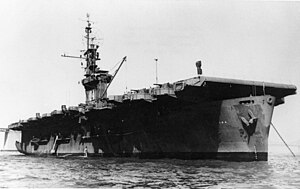 USS Munda (CVE-104) in San Francisco Bay, 1945
| |
| History | |
|---|---|
| Name |
|
| Namesake |
|
| Ordered | as a Type S4-S2-BB3 hull, MCE hull 1141[1] |
| Awarded | 18 June 1942 |
| Builder | Kaiser Shipyards |
| Laid down | 29 March 1944 |
| Launched | 27 May 1944 |
| Commissioned | 8 July 1944 |
| Decommissioned | 24 April 1946 |
| Stricken | 1 September 1958 |
| Identification | Hull symbol: CVE-104 |
| Honors and awards | 1 Battle star |
| Fate | Sold for scrap on 17 June 1960 |
| General characteristics [2] | |
| Class and type | Casablanca-class escort carrier |
| Displacement |
|
| Length | |
| Beam |
|
| Draft | 20 ft 9 in (6.32 m) (max) |
| Installed power |
|
| Propulsion | |
| Speed | 19 knots (35 km/h; 22 mph) |
| Range | 10,240 nmi (18,960 km; 11,780 mi) at 15 kn (28 km/h; 17 mph) |
| Complement |
|
| Armament |
|
| Aircraft carried | 27 (combat functionality) |
| Aviation facilities | |
| Service record | |
| Part of: |
|
| Operations: | Operation Magic Carpet |
USS Munda (CVE-104) was the last of fifty United States Navy Casablanca-class escort carrier built for service during World War II. She was named after the Battle of Munda Point, which occurred on the island New Georgia, a part of the Solomon Islands in 1943. The ship was launched in May 1944, and commissioned in July, and served as an aircraft transport and as a replenishment escort carrier in the Pacific Theatre. Postwar, she participated in Operation Magic Carpet, the repatriation of U.S. forces from bases scattered around the Pacific. She was decommissioned in April 1946, when she was mothballed in the Pacific Reserve Fleet. Ultimately, she was sold for scrapping in June 1960.
- ^ Kaiser Vancouver 2010.
- ^ Chesneau & Gardiner 1980, p. 109.